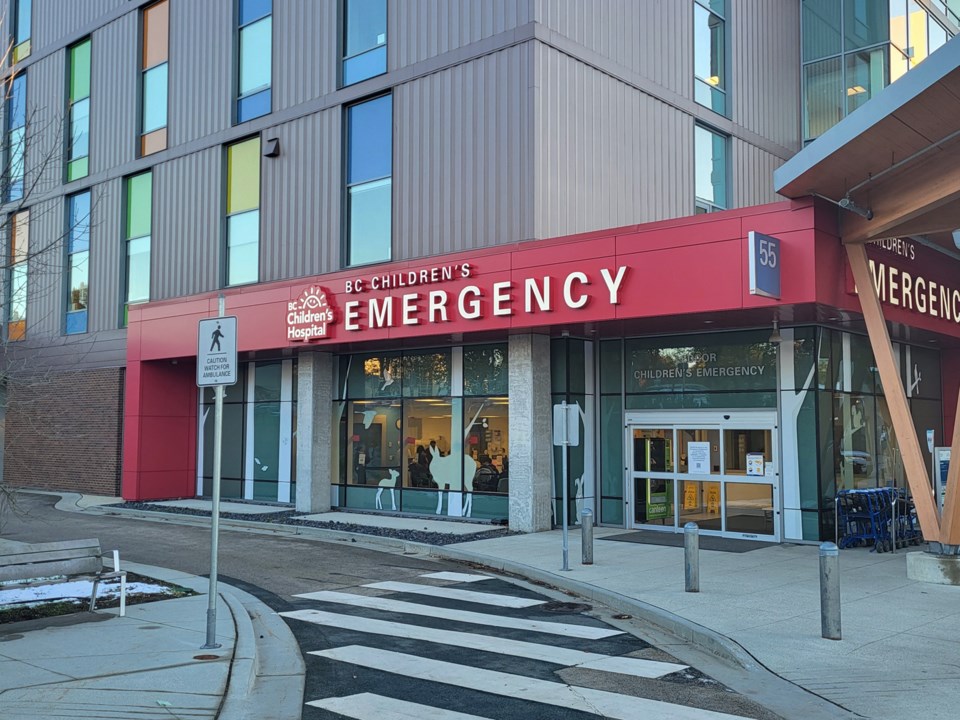After hospital emergency wait times routinely exceeded 10 hours and a severe flu killed six children last year, BC Children’s Hospital has issued “guidance” to families on how and where to access care this year.
The hospital said, in a statement Thursday, its own emergency department provided care to over 13,000 children during respiratory illness season, last October through to December, and more than one-third of those patients could have been treated non-urgently, outside of an emergency care environment.
The hospital makes it clear, however, that if you need such care then you should visit the emergency room or call 911 for an ambulance.
“Our message to families is simple: if your child has an emergency health concern, our specialist [emergency department] team are prepared to provide exceptional care to them,” said Dr. Garth Meckler, head of emergency medicine.
But Meckler cautioned that, “clinicians must first focus their attention on children with the most urgent issues first” — as such the hospital is advising families with less urgent needs to be prepared to wait; they should bring phone chargers, snacks, drinks, toys, books “and other items to support and soothe their child.”
While not noted in the statement, families arriving by vehicle will also need to pay for parking after the provincial government re-instated those fees at emergency rooms, after they had been lifted since the COVID-19 pandemic and until March 2022.
Among the most common non-urgent concerns, according to the statement, were “fever and milder respiratory symptoms (cough and congestion), nausea/vomiting, mild abdominal pain, and earache. Conversely, the most common urgent concerns were children with moderate to severe respiratory distress.”
“Symptoms deemed non-urgent “may be managed by a family doctor, walk-in clinic or an urgent and primary care centre, if available in your community,” stated the hospital.
Families observing such symptoms can access medical advice any time by calling 811. Last month, BC Children’s also launched Sunny Bear chat bot to advise families of hospital services and to provide tips on staying well during respiratory season.
Christy Hay, the executive director of clinical service delivery, said the hospital “reviewed the operational adjustments made last year in preparation for the respiratory season ahead.”
Respiratory illness season in early days, yet to strike
So far, according to the B.C. Centre for Disease Control’s Respiratory Epidemiological Summary for Oct. 12, respiratory season has yet to kick off, as pediatric hospital visits remain below levels from the past two years. The report monitors three key viruses/illnesses: flu, RSV and COVID-19.
So far, SARS-CoV-2 levels have increased at all wastewater plants across the province while positive tests of flu and RSV remain low and below or comparable to pre-pandemic levels, for all of the province.
Fall 2022 overwhelmed BC Children's Hospital
Last year the province was struck by a more severe pediatric respiratory illness season after “low activity” in 2020/21 and 2021/22.
For children especially, the flu hit early and hard, noted the B.C. Centre for Disease Control’s 2022/23 respiratory season report.
Among children, peak test positivity for Influenza A (41 per cent) was “significantly higher” than the 2014/15 to 2018/19 historical average (16 per cent). After the peak in mid-November, however, rates declined well below average into early 2023.
At the peak in November 2022, respiratory illnesses accounted for 50 per cent of all emergency department visits for children age 5-11, as opposed to about 20 per cent the year before.
And RSV peaked in late December with test positivity approximately double the historical average for the entire population.
Meanwhile, the SARS-CoV-2 virus detections “remained relatively stable” with test positivity fluctuating from two per cent in September to 15 per cent towards the end of April.
“Even though they remained within the upper bound of historical range, pediatric visit rates were some of the highest seen in the last 13 years. This observation may reflect the low levels of influenza circulation during the prior two respiratory seasons, leaving more people being susceptible to influenza infection in 2022/23,” the report noted.

